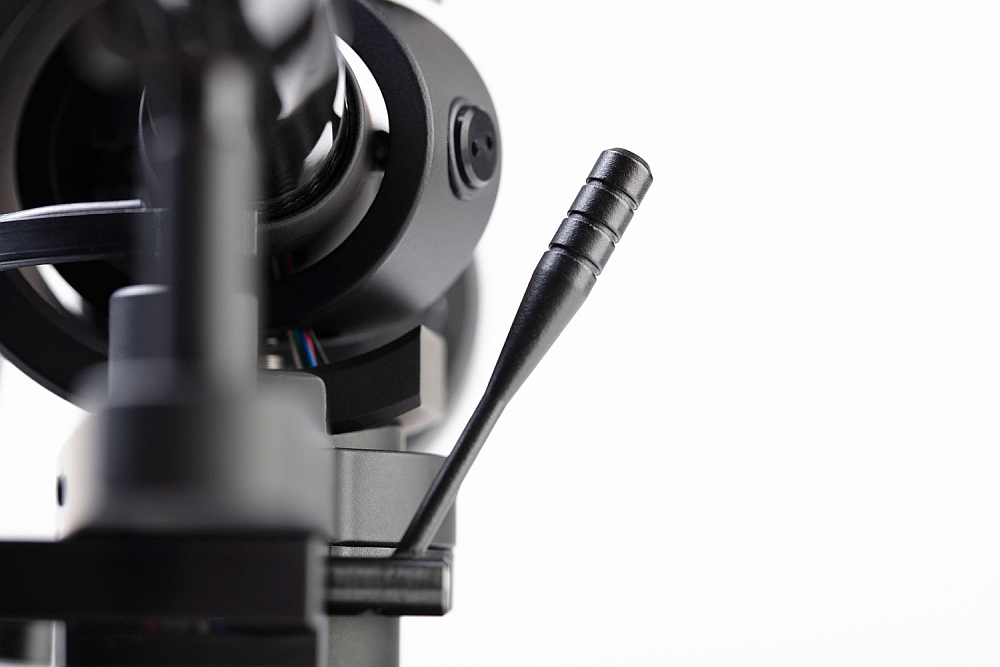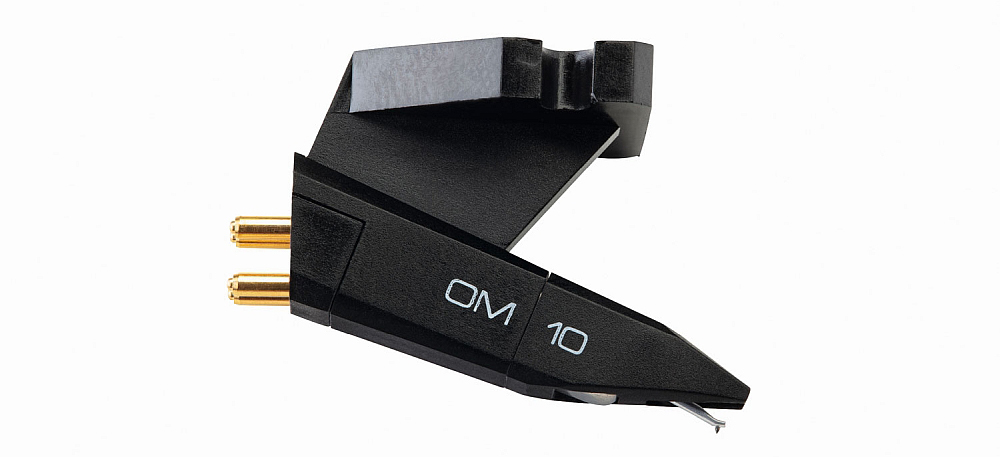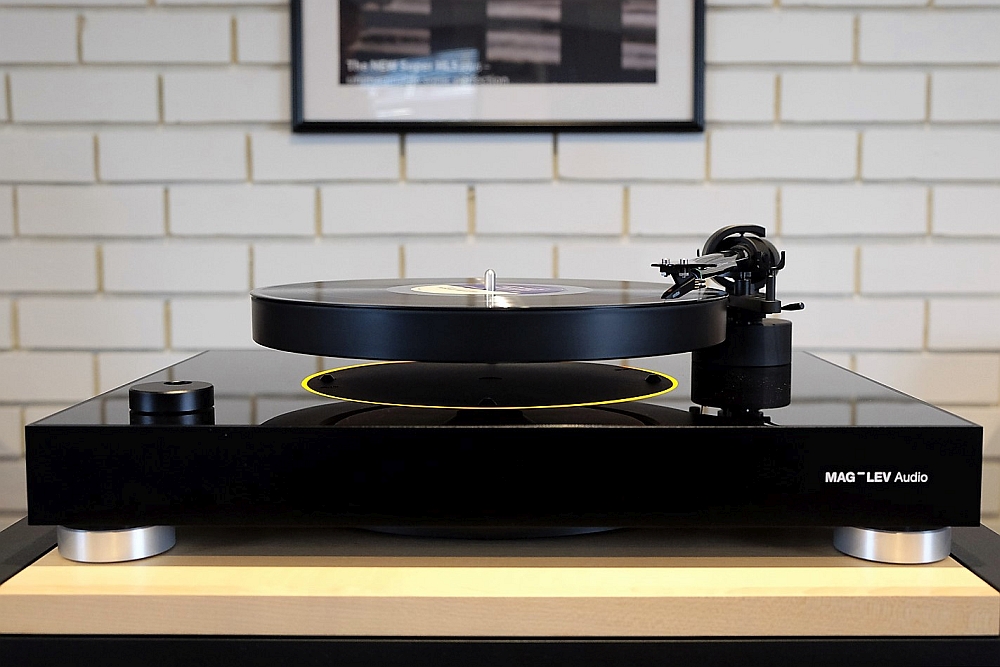In an industry which has only relatively recently come out of a conservative period in terms of product styling – Devialet, D’Agostino, first come to mind as among the first to break out – and also its technology evolution, along comes a new company, headquartered in an unlikely location and hitting the market with a sole product offering a unique take on the record spinning concept. The MAG-LEV ML1 is a turntable that literally breathes fresh air…
Magnetic Attraction
MAG-LEV hails from Slovenia, an uncommon place for audio manufacturing with analogue and loudspeaker specialists Kuzma and Ubiq Audio possibly being the sole compatriots, in terms of the wider industry consciousness and just off the top of my head. MAG-LEV’s first product is the ML1, a crowd funded exercise that has arisen to fruition in a big way. Certainly, the concept is a total departure from the current crop of ever-growing turntable manufacturers that have joined the ranks exponentially as vinyl playback achieved increasing popularity.
The concept is in principle, quite simple. Its execution, however, I’m sure presented a number of challenges the MAG-LEV engineers had to surmount in order to cater for the product’s safety, reliability and then, importantly, performance. Responsible for the overall design was a team of passionate music lovers with experience in a number of fields including engineering, industrial design, manufacturing/production and logistics.

So the ML1 is a basic turntable with a ‘Magnetic Coil Drive’ that caters for 33 RPM and 45 RPM. This is enclosed within a mainly ABS plastic plinth (body and top face are available in a number of finishes) that houses the tonearm mount, the magnet system, a circular lighting visual accent and a support system for the platter when it’s non-operational. In Australia, the ML1 is packaged with a simple but proven Pro-Ject 9cc 9-inch carbon fibre tonearm, a well-respected mid-entry-level Ortofon OM10 Moving Magnet (MM) cartridge and a nicely-made German Sommer 1m RCA cable with integrated ground wire. The rear of the turntable features twin gold plated RCA sockets and a ground post.
Being a simple design, the specifications provided by MAG-LEV are basic – no more is needed really. The ML1 is specified as having a Wow & Flutter of 0.17 percent, a reasonable Signal-to-Noise Ratio (SNR) of -73dB while the 2.2kg platter is constructed from a composite of ABS plastics, carbon fibre and a mix of metals and magnets. These, of course, are the star attractions here. The platter’s magnet system – embedded within a ‘ridge’ – mates with a number of small, yet powerful magnets which are evenly arrayed around the bottom perimeter of the platter and the plinth area directly below. This, in simple terms, is the crux of the levitation system.
Initial setup is quite straightforward. Once you’ve placed the ML1 on a sturdy and level surface – this is of utmost importance, as I found out – the next step is to place the platter on to the turntable body. Then, while holding the platter firmly with two hands, you start lowering it towards the posts. This requires care as the magnet systems will pull and push to either side of the location position until you reach a point where a ridge on the platter’s underside (where the magnets are housed) registers with the support posts. The ML1 has to then be switched to its configuration mode where a short period of whirrs, buzzes and flashing control knob light signal a form of calibration process. Once the flashing stops, the setup process is done.
The ML1 comes packaged with both the tonearm and cartridge pre-mounted so all that is required is the attaching of the anti-skating weight and nylon thread and counterweight. MAG-LEV supplies the required Allen key to adjust the armboard’s height in relation to the platter which is done via two side-mounted inset bolts. Overall, the tonearm setup is simple enough and along the lines of what is needed on a traditional turntable system.

Of course, this last step requires the operation of the turntable. This is a rather wondrous thing when done for the first time. A large round main controller on the unit’s left hand side is used to operate the initial calibration, on/off and the platter’s speed. Switch this to 33 ⅓ RPM and watch as the platter support posts slowly (and quite noisily in terms of motor whirrs) descend into the plinth’s body while the platter begins its floating spin. The 33 ⅓ LED within the round controller flashes until the proper speed is finally reached. Then, in a buzz of a visual, you see the platter fully floating in space as it spins while being lit from below by a circular amber LED system. Yeah!
It’s important to also note that the free-air platter spinning only takes place when you’re actually about to play a record. At all other times, the platter simply rests on the support posts. Conveniently, the arm rest has built-in sensors which automatically stop the platter and, once again, raise the support beams. Similarly, should a power loss or blackout occur, the system has enough reserve energy to perform an emergency stopping of the platter and support beam raising exercise. Oh, and once your record is done playing, the ML1 automatically raises the tonearm and, after a time lapse, turns itself off.
The ML1’s finish quality is adequate, although overall it’s somewhat plasticky and does not reach the same standards as some of the big name opposition at a similar price point. However, these others are conventional in their design. As mentioned above, the ML1 is available in a number of colour options which also include gold or silver feet.

Now, as far as placement of the ML1, I have to stress the importance of a solid and level platform. I initially setup the ML1 on a small wooden table alongside the main rack and found that after the platter reached the speed I selected (33 ⅓ RPM), there was an unacceptable amount of vertical wobble which prohibited proper operation. Changing the ML1’s location onto a far better support resolved this issue (please note that a small amount of ‘wobble’ is normal and does not affect playback). Moral of the story? As per any turntable product, but even more so than most, the ML1 demands appropriate isolation and vibration control via a solid platform.
Floating Your Boat
As a ready to go package – once the arm is setup – all that’s needed is connecting the ML1 to a phono input, in this case the over-achieving REDGUM Audio RGPH2 phono stage. I used the cable supplied as that’s the way the majority of users will connect the ML1, however, I also tried one of my own cables in the $500 price range.
Once the visuals, the pyrotechnics and pomp and circumstance, of this unique turntable are familiar, you’ll start discerning sonic performance and you’ll notice it’s one marked by a sense of smoothness and easy listening. Throughout its time in situ and across all music genres and many, many LPs the ML1 never showed signs of forwardness or brightness. This made for a sound that was sympathetic and forgiving of modern brash recordings and poor digitally remastered vinyl pressings.

As pleasant as that may be, this translates as the ML1 being a tad reticent in terms of dynamics. All the music is there, but it won’t shout at you nor will it flip your wig in terms of power of expression. Conversely, the bass region is always tight and punchy with a good sense of pace… that rhythm thing. And perhaps this rhythm aspect, tied in with the ML1’s smoothness is somehow connected to the very quiet playback – it’s the lowness of the noise floor – that ‘black’ background usually associated with digital.
Detail retrieval is good as is separation during complex passages. The intricacies of saxophone, drums and piano on Dave Brubeck’s Take Five were maintained and presented with good tonality and even better delineation with a clear impression of each of the instruments and their placement within the soundstage.
Tangarine Dream’s Underwater Sunlight record was mellowed via the ML1. This DMM (Direct Metal Master) pressing can be a tad brash but features tremendous dynamic contrasts throughout. Atop the ML1 floating on air, the brashness and upper midrange etch was relieved somewhat, again, making the music more listenable even if the drama in terms of dynamics was arrested to some extent.

Ditto for The Doors’ Weird Scenes Inside The Gold Mine compilation, where one of my favourite tracks “The End” preserved its atmospherics and ‘feel’ even if the mania of the final explosion was slightly softened. Morrison’s vocals were nicely presented centre stage with his usual deep growl cutting through the atmos.
Conclusion
While I’m unfamiliar with the Ortofon OM10 cartridge, I have confidence in the prowess of the excellent-for-the-money Pro-Ject 9cc arm which I’ve heard on several occasions. Similarly, while the concept of levitation is sound in terms of the resultant low vibrational and near-zero friction distortions, questions could be raised regarding the possible interactions between the ML1’s powerful magnet system and the cartridge’s own.
Having said that, the ML1 performed appropriately in terms of its sonic abilities with special mention of its bass punch and rhythm. And while I found its dynamic capabilities somewhat reticent, the midrange and treble were sweet, detailed and resolving enough to provide proper satisfaction in entry to mid-level stereo systems.
However, the biggest kudos must go the design team and its clever all-round execution of the levitation system which, while in situ, worked flawlessly. Hey my Yogi friend, did I tell you that levitation is way, way cool?
… Edgar Kramer
This email address is being protected from spambots. You need JavaScript enabled to view it.
Associated Equipment
- Speakers — Wilson Audio Alexia Series 2, Axis Loudspeakers VoiceBox S (nearfield monitor), Vermouth Audio Little Luccas Mk.II
- Amplifier — Gryphon Audio Antileon EVO
- Preamplifier — Supratek Cortese, Lightspeed Attenuator LDR passive
- Sources — Digital: Yamaha CD-S2100 transport, Totaldac d1-core DAC, MacBook with BitPerfect software, AIFF files. Analogue: Michell Engineering Orbe with Gert Pedersen Level 3 modifications and Origin Live Ultra upgraded motor, Trans-Fi Terminator air bearing linear-tracking arm, Shelter Harmony cartridge, Supratek Cortese & REDGUM Audio RGPH2 phono stages
- Processor — DEQX PreMate
- Cables — sILENzIO loom, Vermouth Audio Black Pearl Mk.II loom
- Audio Rack — SGR Audio Statement Model V
- Miscellaneous — Les Davis Audio Viscoelastic CLD discs
MAG-LEV Audio ML1 Magnetic Levitation Turntable
Price: AU$3495
Warranty: Two Years
Australian Distributor: Audio Magic
+61 3 9489 51 22
www.audiomagic.com.au
MAG-LEV Audio d.o.o.
Industrijska cesta 6
5000 Nova Gorica
Slovenia
www.maglevaudio.com











